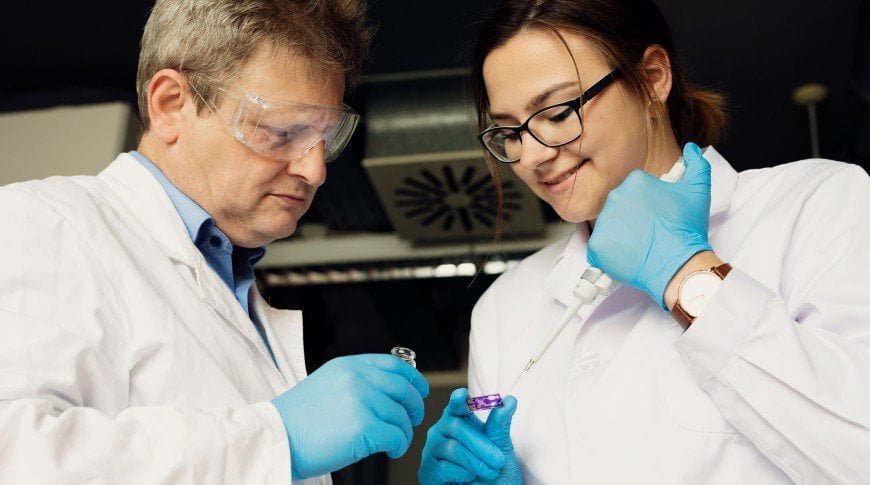
Long waiting periods for lab results could soon be over. An interdisciplinary research team led by Wolfgang Ensinger, Professor of Materials Science, and Helmut Schlaak, Professor of Electrical Engineering and Information Technology, both of TU Darmstadt, are now working with Ivana Duznovic, chemist, and Mario El Khoury, electrical engineer, on the design of a prototype lab-on-a-chip system. This system detects substances directly on site.
Inspired by biological nanopores
The scientists drew their inspiration from nature. This is because biological nanopores, which are integrated within cell membranes, ensure that substances are transported from the outside to the inside, or from the inside to the outside. They function either as sluices or as selective transport systems. Another special feature is that they are specialized when it comes to specific substances.
To date, there is no technical system available that is able to match the sensitivity and specificity of biological nanopores. Their performance is unparalleled. However, biological nanopores themselves are unsuitable for technical applications. They are simply too fragile.
Ensinger and Duznovic therefore rely on synthetic nanopores which they equip with a chemical or a biological sensor. To do this, the surfaces of the nanopores are made functional accordingly.
“Our goal is to design a new generation of sensors that are highly sensitive and efficient, based closely on their biological counterparts,” Ensinger explains. “If we then integrate these bio-inspired sensors into a microfluidic system with a portable electronic analysis system, then they become a lab-on-a-chip system,” Schlaak adds.
System works just as accurately as laboratory
Microchips that directly measure substances on site are a dream come true for both physicians and environmental analysts. Until now, samples had to be sent to a laboratory in order to e.g. diagnose a disease, monitor its progress or test the contamination of wastewater with pesticides or drugs. This in turn often entails a long waiting period for the results. In an effort to develop a new generation of sensors that are highly sensitive and powerful based closely on their biological counterparts, the interdisciplinary team at TU Darmstadt has now presented its patented “lab-on-a-chip” prototype. It is no larger than a credit card, but has the functionality of a laboratory. And it works even faster, more cost-effectively and with less required effort than a conventional laboratory. This is because the values are determined during the visit to the doctor or at the testing site. Nonetheless, the system is just as precise, robust and reliable as a laboratory.
Several processing steps are necessary
A number of steps are, however, necessary for production. First, the synthetic nanopores need to be produced. This is done by bombarding polymer films with heavy ions. This job is carried out by the GSI Helmholtz Center for heavy ion research in Darmstadt. After impacting the polymer films, the nanopores are made bigger and transformed into a conical shape. They then have a narrow and a wide opening and look similar to a funnel. The nanopores are enlarged by treating one side of the film with a caustic solution.
“The caustic process creates free carboxy groups, by which we are then able to activate the nanopores via a chemical cross-coupling reaction,” Ivana Duznovic explains. “Basically, we are able to attach all kinds of substances to the carboxy groups. However, it only makes sense to use substances that are biologically or chemically relevant and which enable us to identify biomolecules with a high degree of specificity and sensitivity that are relevant for diagnosis or environmental analysis. The sensor would otherwise make no sense.”
Nanopores can be regenerated
The nanopores were activated specifically for the detection of histamine. This messenger substance plays a central role in allergic reactions and could also be important in the treatment of Alzheimer’s disease. The detection method conceived by Ensinger and Duznovic is based on a displacement reaction. A substance coupled to the carboxy group binds on to a metal ion that can also bind on to histamine. If the sample contains histamine, the metal ion transforms into histamine, which can be recognized by a drop in the electrical current of the nanopores. The following applies: the greater the decrease in electrical current, the more histamine is contained in a sample. Since the substance coupled to the carboxy group is able to be recharged with the metal ion, the nanopores may be regenerated and used for further detection.
From prototype to system
The next step is the development of the ‘lab-on-a-chip’ system.
“We already have a functional microchip, but some problems still need to be resolved because the detection is not just supposed to work in an aqueous solution, but also in a blood sample,” according to Schlaak.
The team would like to be able to recycle the chip in order to cut down on costs. This is also theoretically possible due to the ability of nanopores to regenerate. For this reason, any later results must not be influenced by the initial use of the chip:
“We must not have any so-called memory effects,” El Khoury says, summing up the problem.
Another hurdle for the commercialization of the product is the search for suitable test subjects who could provide relevant proof, as is the case in medicine.
“We need a marker that has already been validated,” Ensinger explains. ” We need to be certain that this method actually makes medical sense and is helpful in diagnostics, screening or the monitoring of the course of a disease, for example,” the materials scientist says and he adds:
“We are currently looking for some interesting candidates and are already collaborating with the University Hospital in Mainz. Of course, we are open to other ideas”.
Interdisciplinary collaboration
A lab-on-a-chip system based on biologically-inspired nanopores can only be developed in close collaboration with other disciplines. Ensinger and Schlaak applaud the interdisciplinary approach of the LOEWE research cluster iNAPO. Chemists, biologists, materials scientists, physicists and electrical engineers have all been involved in the development.
“We at the TU Darmstadt are very well positioned for such projects,” said Ensinger enthusiastically. Next, the team wants to equip the surfaces of the nanoprobes with equipment that enables the detection of proteins in order to identify complex biomarkers.








